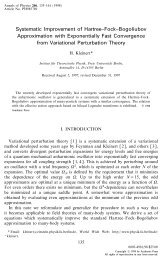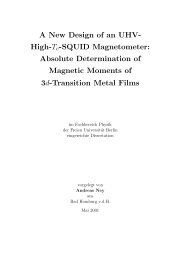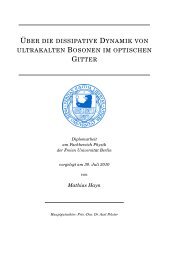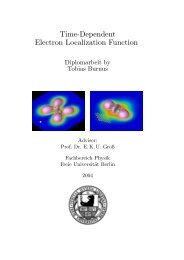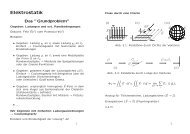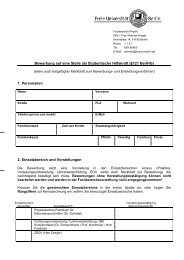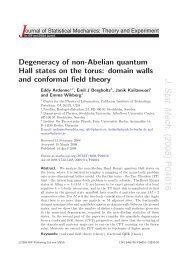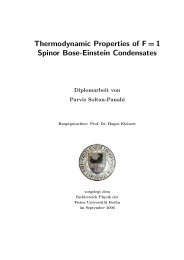Diploma thesis
Diploma thesis
Diploma thesis
You also want an ePaper? Increase the reach of your titles
YUMPU automatically turns print PDFs into web optimized ePapers that Google loves.
4.1 Static solutions of Schrödinger equation<br />
since lim ω→∞ Γ (a, ω 2 ) = 0. Before inserting this into the wave function (4.68) in area 2 we have<br />
to consider that this is only the absolute value of N s and also includes only the absolute value<br />
of R s which are in general complex numbers. Thus we have to add an arbitrary phase factor<br />
N s = |N s | e iϕ , R s = |R s | e iϑ . We already know ϕ = nπ from the real limit, when area 2 vanishes,<br />
and, since R s only contains real functions for ω → ∞, we can state |R s | = R s . This seems to be<br />
right since exactly ϑ = 0 leads us to the correct wave function<br />
ψ2,∞ s (χ) = ψ∞ s (χ) = (−1) n (2n)!<br />
√<br />
(<br />
1<br />
√ 1<br />
n! π2<br />
2n<br />
(2n)! e− 2 χ2 1F 1 −n; 1 )<br />
2 ; χ2<br />
√<br />
1<br />
= √ 1 π2<br />
2n<br />
(2n)! e− 2 χ2 H 2n (χ) . (4.70)<br />
Thus, we have<br />
√ ψ∞ s √ λ 1<br />
(√ )<br />
(x) =<br />
1 π 2 2n (2n)! e− 2 λx2 H 2n λx = ψ<br />
s<br />
0 (x). (4.71)<br />
So finally we got in some sense the same result as for the complex square well potential since<br />
the wave function and the real part of the energy yield nothing else than the real limit and only<br />
the imaginary part of the energy provides something new. Thus the imaginary potential does<br />
not influence the wave function qualitatively but yields an imaginary part of the energy which is<br />
linear in c. The interesting issue is that this seems to be independent of the particular shape of<br />
the imaginary potential since in both cases, square well in the limit ω → π/2 as well as harmonic<br />
potential for ω → ∞, we get the same result for the imaginary part.<br />
4.1.2 Antisymmetric states<br />
Let us now evaluate along similar lines the antisymmetric wave function (4.23), that means the<br />
wave functions ψ a 1, ψ a 2, ψ a 3 have to fulfill<br />
ψ a 1 (−χ) = −ψ a 3(χ) , ψ a 2 (−χ) = −ψ a 2 (χ) . (4.72)<br />
Next we derive conditions for A a 2 and ε by demanding continuity and differentiability of ψ a at<br />
χ = −ω. But first of all we change slightly the notation for ψ 1 , which seems to be reasonable in<br />
the antisymmetric case. Instead of expressing A a 1 via A s 1 we now do it vice verca and get for the<br />
constant of the antisymmetric part<br />
A s 1 = A a 1 lim χ→∞<br />
χ 1 F 1<br />
(<br />
a1 + 1 2 ; 3 2 ; χ2)<br />
1F 1<br />
(<br />
a1 ; 1 2 ; χ2 ) . (4.73)<br />
Performing an analogous discussion as we did for A s 1 provides correspondingly<br />
47




